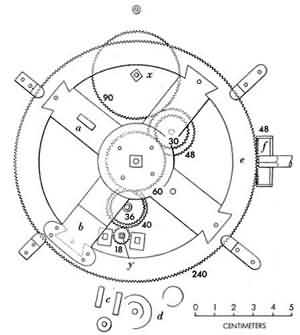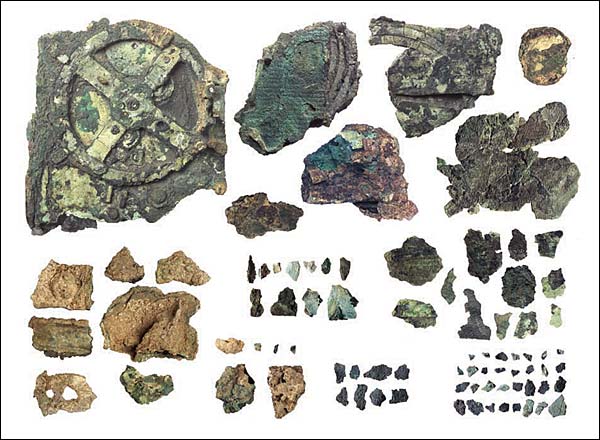The Discovery:

The main
fragments of the original
device.
The device was first found over a
hundred years ago (c. 1900) by sponge divers on a shipwreck at the bottom of the sea near the island of Antikythera.
The gradual realisation that it was a sophisticated astronomical
calculating device astonished experts around the world. For decades
however, scientific
investigation failed to yield much more about it, but modern
equipment has begun to reveal its secrets. It dates from around the
end of the 2nd century B.C. and is the most sophisticated mechanism
known from the ancient world. Nothing as complex is known for the
next thousand years. The Antikythera Mechanism is now understood to
be dedicated to astronomical tool operating as a complex
mechanical "computer" which tracks the cycles of the Solar System.
The Object - A Description.
 The
device contains a complicated arrangement of at least 30
precision, hand-cut bronze gears originally housed inside a wooden case covered
with inscriptions which describe how to use it.
The
device contains a complicated arrangement of at least 30
precision, hand-cut bronze gears originally housed inside a wooden case covered
with inscriptions which describe how to use it.
The device is remarkable for the level of miniaturization and for
the complexity of its parts, which is comparable to that of 18th
century clocks. It has over 30 gears with teeth formed through
equilateral triangles. When a date was entered via a crank (now
lost), the mechanism calculated the position of the Sun, Moon, or
other astronomical information such as the location of other
planets.
The mechanism has three main dials, one on the front, and two on
the back. The front dial has two concentric scales. The outer ring
is marked off with the days of the 365-day Egyptian calendar, or the
Sothic year, based on the
Sothic cycle. Inside this, there is a second dial marked with
the Greek signs of the Zodiac
and divided into degrees. The calendar dial can be moved to
compensate for the effect of the extra quarter day in the year
(there are 365.2422 days per year) by turning the scale backwards
one day every four years. Note that the
Julian calendar, the first calendar of the region to contain
leap years, was not introduced until about 46 BC, up to a
century after the device was said to have been built (and the leap
year was implemented with errors until the early first century).
The front dial probably carried at least three hands, one showing
the date, and two others showing the positions of the Sun and the
Moon. The Moon indicator is adjusted to show the first anomaly of
the Moon's orbit. It is reasonable to suppose the Sun indicator had
a similar adjustment, but any gearing for this mechanism (if it
existed) has been lost. The front dial also includes a second
mechanism with a spherical model of the Moon that displays the
lunar phase.
There is reference in the inscriptions for the planets Mars
and Venus,
and it would have certainly been within the capabilities of the
maker of this mechanism to include gearing to show their positions.
There is some speculation that the mechanism may have had indicators
for all the five planets known to the Greeks. None of the gearing
for such planetary mechanisms survives, except for one gear
otherwise unaccounted for.
Finally, the front dial includes a parapegma, a precursor to the
modern day
Almanac, which was used to mark the rising and setting of
specific stars. Each star is thought to be identified by Greek
characters which cross reference details inscribed on the mechanism.
The upper back dial is in the form of a spiral, with 47 divisions
per turn, displaying the 235 months of the 19 year
Metonic cycle. This cycle is important in fixing
calendars.
The lower back dial is also in the form of a spiral, with 225
divisions showing the
Saros cycle; it also has a smaller subsidiary dial which
displays the 54 year "Triple Saros" or "Exeligmos" cycle. (The
Saros cycle, discovered by the
Chaldeans, is a period of approximately 18 years 11 days 8 hours
-- the length of time between occurrences of a particular
eclipse.)
The Antikythera Mechanism Research Project, with experts from
Britain, Greece and the United States, detected in July 2008
the word "Olympia" on a bronze dial thought to display the 76 year
Callippic cycle, as well as the names of other games in ancient
Greece, and probably used to track dates of the ancient Olympic
games. According to BBC news:
"The four sectors of the dial are inscribed with a year number
and two
Panhellenic Games: the 'crown' games of
Isthmia,
Olympia,
Nemea, and
Pythia; and two lesser games: Naa (held at
Dodona) and a second game which has not yet been deciphered."
One of the remarkable proposals made by Price was that the
mechanism employed
differential gears, which enabled the mechanism to add or
subtract
angular velocities. The differential was used to compute the
synodic
lunar cycle by subtracting the effects of the Sun's movement
from those of the
sidereal lunar movement.

It was announced in
Athens on
21 October 2005
that new pieces of the Antikythera mechanism had been found. There
are now 82 fragments.